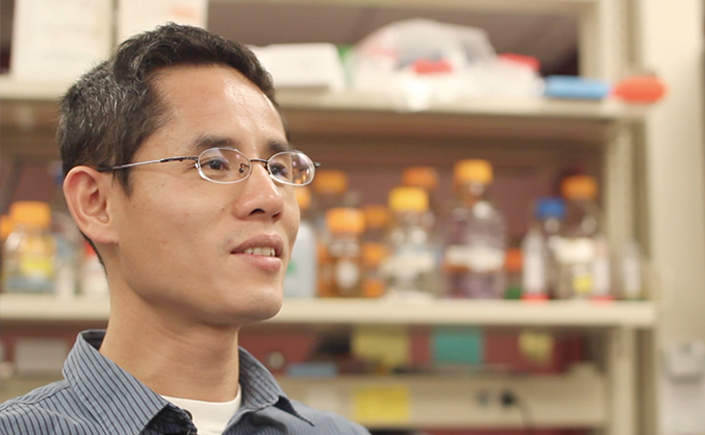
With the world hungry for more and better nutrients, antibiotics, plastics and other materials, a cheap and sustainable source must be found. Enter Kechun Zhang, who works with the most abundant of all: sugar.
“Sugar is the basis of life,” explains Zhang, a 2015-17 McKnight Land Grant Professor in the College of Science and Engineering’s Department of Chemical Engineering and Materials Science (CEMS). “Everything is made of sugar or sugar-derived materials. Plants turn carbon dioxide into sugar, and it’s fed into all of life, including the cellulose in plant cell walls and the starches in seeds.”
Zhang and his colleagues—notably Regents Professor Frank Bates and chemistry professor Mark Hillmyer—have used various sugars as feedstocks to produce the building blocks of plastics, elastic materials (including spandex) and other products. This year, the three researchers founded the company Valerian Materials to manufacture the building blocks (monomers) of high-performance, biodegradable plastics and other polymers from renewable stocks instead of petroleum.
In 2013 Zhang started another U of M company, Ascenix BioTechnologies, to develop new biochemical techniques to produce monomers from renewable sources. In collaboration with a leading chemical company, Ascenix recently produced a biobased material that is impermeable to carbon dioxide and could be used in soft drink bottles to keep the drinks from going flat.
“Kechun Zhang brings to the University’s Chemical Engineering program new and innovative approaches to producing the chemicals that influence the world we live in,” notes Bates.
This research starts with genetically engineering yeast and bacteria to perform chemical transformations beyond nature. Here are some examples of how Zhang and his colleagues do it.
Spun from Sugar: Cost-Competitive Polyesters
With postdoc Mingyong Xiong, Zhang engineered microbes to turn sugar into a new monomer called MVL. Next, Hillmyer, Bates and chemistry graduate student Deborah Schneiderman stitched polymers of MVL together with polymers of lactide, a monomer derived from cornstarch, to form a hybrid polyester known as a block co-polymer.
By varying the ratio of MVL to lactide, the team could “tune” the new polyester to various degrees of stiffness, even producing a version that could be repeatedly stretched to 18 times its original length. This erased a critical flaw of lactide, which has been the most successful bio-based synthetic polymer but is too rigid to find wide usage.
“These polymers can also be tuned to vary properties like durability versus biodegradability,” Zhang notes. For this work, he received a University of Minnesota Early Innovator award.
From Sugar to Spandex
Early in 2016, Zhang and colleagues published their work converting sugars derived from agricultural waste such as cornstalks, sugar beet pulp and orange peels into amino acids—used in chicken feed—and spandex. They genetically modified bacteria to produce a key chemical, called DOP, by a simpler, cheaper route. DOP can be steered into the production of amino acids or be transformed into a precursor of spandex.
In this work the researchers bypassed a normal pathway—called glycolysis—that operates in both microbes and humans. It breaks sugars down in stepwise fashion and feeds the products into a second phase of metabolism that leads to amino acid production. But glycolysis is slow because its regulation is complicated.
However, “in [our] engineered pathways, the reactions go faster and yield higher amounts of carbon,” Zhang says.
He credits the McKnight Professorship in helping keep the focus on novel pathways. “We’re opening possibilities to make other products,” he says.
“Kechun’s drive to solve tough problems in the sustainable polymer arena is impressive,” says Hillmyer. “His creative and innovative approaches to new sustainable molecules from renewable resources have been important to the success of the Center for Sustainable Polymers.”
Bright Future
Among the products on the horizon is plastic tubing for medical and consumer use. For example, says Zhang, a temporary, surgically implanted tube, made from plastic the body can degrade, could replace metal tubes that require a second operation to remove.
“Our plastics work fine with normal use, but soil bacteria can metabolize them,” Zhang says. “We want to improve the quality of our lives with sustainable, affordable materials with properties that are better, both for their uses and for the environment.”